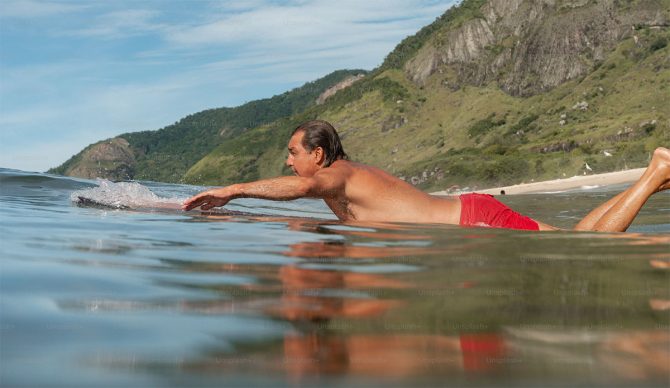
Surfer’s Back is often attributed to having bad posture, but a growing body of research suggests that “good posture” is entirely subjective. Photo: Unsplash
If you surf — which, if you’re reading this, there’s a decent chance you do — you’re aware that it can wreak havoc on your back. It’s so common that medicine gave a specific type of pain a name: “Surfer’s Back.” We’ve been told for years that “bad posture” can lead to back pain, but a growing body of research suggests that bad posture is completely subjective.
“..there is no definitive link between specific postural habits and pain,” writes Physiopedia.com. “In fact, posture varies greatly among individuals, and what may be considered a ‘good posture’ for one person may not work or feel comfortable for another.”
Really quick, here’s a TLDR about what, exactly, posture is. “Posture is the attitude assumed by the body either with support during muscular inactivity, or the coordinated action of many muscles working to maintain stability. It forms an essential basis that is being adapted constantly,” Physiopedia.com explains. “Our posture is an active process involving not only our muscles and joints but also our perception, emotions, and the environment we are in. Even seemingly static positions, like sitting or standing, are full of tiny adjustments and movements.”
Surfers spend a lot of time in the prone position. When we paddle our back is arched and our head is up. Over time, that constant extension of the lumbar puts a ton of strain on the lower back. And since our bodies are pretty interconnected, combined with the turning and twisting movement we do when turning, problems can compound throughout the body. Core muscles, hip flexors, thigh muscles, and more can all be affected and lead to chronic pain.
Most of us might attribute the pain to a combination of excess strain and generally poor posture. It’s easy to assume that your poor posture might be stemming from all that excess strain. If you’re like me, you try and mitigate the issues with stretching, avoiding that dreaded “text neck,” and trying to hold your shoulders back. Slouching has long been thought to be a bad thing, but that research I mentioned at the top hints that having what we think of as good posture might not actually be all that beneficial.
Before we go much further, it should be noted that, according to the National Institute of Health, slouching can cause your spine to become more fragile and make it more prone to injury. But that’s a bit of a blanket statement, since our bodies aren’t one-size-fits-all.
According to Dr. Mark Queralt, who works as the medical director at the Musculoskeletal Institute at the University of Texas at Austin, some people feel better a bit slumped. Especially older folks or people with spinal conditions like arthritis.
“To have that person sit straight and arch their back all day long would be painful,” Queralt told the Huffington Post for an article called “Standing Up Straight Might Not Be As Beneficial As We Thought.” Queralt went on to explain that it’s natural for the spine to evolve and assume different postures as we age. “What would you think your spine is going to look like at 60?” he asked. “Would you expect it to look like you’re 30 or would you expect changes?”
More important than good posture is good spinal strength and overall flexibility. According to Dr. Scott Mallozzi, a spine surgeon at UConn Health, if you want to have the best shot at surfing for longer without pain, reminding yourself to stand up straight all the time isn’t the best option. Instead, focusing on strengthening specific muscles will help support your spine throughout its many and varied movements.
“There are two muscle groups that work well to help you with posture,” Mallozzi said. “The first group is your paraspinal muscles, which are the muscles that surround your spine from your neck to your lower back. If you have a strong group of muscles around your spine, your discs and joints will have to do less work because they’re better supported. The other muscle group that’s important to work is your core, which will further help support your back.”
If you focus on those muscle groups, it’s likely that you’ll end up with what we think of as good posture, anyway. Things like yoga, shoulder-blade squeezes, and planks are good, basic exercises. Mallozzi said those, and similar exercises, “really do help people achieve this musculature that is supportive of good posture.”
Of course, those aren’t a panacea, but if you focus on them when you’re still young, you stand a better chance of avoiding issues as you age. Even if you’re not young anymore, the body is a resilient thing. Movement is the key, which can be difficult in today’s day and age. Sitting all day is bad, but so is standing all day. And if you want to surf to a ripe old age, remember that “good posture” isn’t everything — movement, flexibility, and strength are what you should be focusing on.

